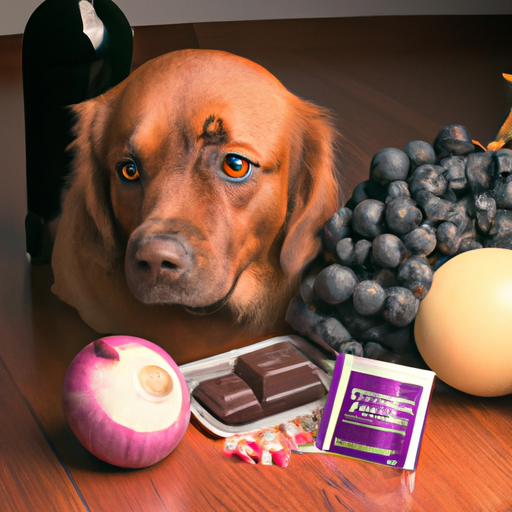As a dog owner, it’s imperative to know that not all human foods are safe for your furry friend. Some foods that we regularly consume can be dangerously toxic for dogs, leading to severe health issues or even death. Therefore, it’s essential to be aware of what not to feed your dog.
Table of Contents
- Introduction
- Foods Toxic to Dogs
- The Science Behind Food Toxicity
- How to Prevent Food Poisoning
- What to Do If Your Dog Eats Toxic Food
- Frequently Asked Questions
Key Takeaways
- Certain human foods can be toxic to dogs
- Different foods have varying levels of toxicity
- It’s essential to monitor what your pet consumes
- Seek immediate veterinary help if your dog ingests toxic food
Foods Toxic to Dogs
Chocolate is one of the most well-known foods toxic to dogs. It contains theobromine, which dogs can’t metabolize as efficiently as humans [1]. It can cause a range of symptoms from vomiting to seizures and, in severe cases, can be fatal.
Grapes and raisins are also highly toxic. They can cause kidney failure, even in small amounts. The exact substance causing the toxicity is still unknown, but it’s best to keep these fruits away from your dog.
Garlic and onions, along with other members of the Allium family, are toxic to dogs. They can cause damage to red blood cells leading to anemia. This includes both raw and cooked varieties.
Alcohol should never be given to dogs as it can cause vomiting, diarrhea, decreased coordination, central nervous system depression, difficulty breathing, tremors, abnormal blood acidity, coma and even death.
Here’s a useful table summarizing more foods that are toxic to dogs:
| Food | Toxic Substance | Symptoms |
|---|---|---|
| Avocado | Persin | Vomiting, diarrhea |
| Caffeine | Methylxanthines | Restlessness, rapid breathing, heart palpitations |
| Macadamia Nuts | Unknown | Weakness, depression, vomiting, tremors |
| Xylitol | Xylitol | Insulin surge, hypoglycemia, liver failure, seizures |
The Science Behind Food Toxicity
The reason why certain foods are toxic to dogs boils down to their metabolic processes. Dogs metabolize foods differently than humans, meaning that some foods can build up to toxic levels in their system. For a more in-depth understanding of why these foods are harmful, check out this article on the science behind dog food toxicity.
How to Prevent Food Poisoning
Preventing your dog from consuming toxic foods involves a combination of vigilance, training, and proper food storage.
- Keep toxic foods out of reach: Store toxic foods where your dog can’t get to them. This might mean using child locks on lower cupboards or storing certain foods in the fridge.
- Train your dog: Teach your dog to “leave it” or “drop it.” This command can be a lifesaver in many situations.
- Be aware during meal times: If you’re eating something your dog can’t have, make sure they’re not in a position to grab dropped food or jump on the table.
- Educate others: Make sure everyone in your household, including guests, knows what they can and can’t feed your dog.
For more tips on preventing your dog from ingesting toxic foods, take a look at this comprehensive guide.
What to Do If Your Dog Eats Toxic Food
If your dog ingests a toxic food, seek veterinary help immediately. The faster you act, the better chance your dog has of surviving and recovering. Depending on the amount and type of food ingested, your vet may induce vomiting or administer activated charcoal to absorb the toxins. For more on what to do in such a situation, One Top Dog has an excellent article here.
Frequently Asked Questions
Q: My dog ate chocolate. What should I do?
A: If your dog ate chocolate, call your vet immediately. They’ll likely ask you about your dog’s weight, the type of chocolate, and the amount consumed to determine the level of toxicity.
Q: Can dogs eat any fruits or vegetables?
A: Yes, many fruits and vegetables are safe for dogs. However, it’s always best to double-check before feeding your dog a new food.
Q: How can I train my dog not to eat harmful foods?
A: Training your dog to follow commands like “leave it” or “drop it” can be very helpful. You can also train your dog to only eat foods given in their bowl or from your hand.
Knowing what foods are toxic to dogs is an essential part of being a responsible pet owner. Ensuring that your furry friend stays away from these foods will help them live a long, healthy, and happy life.



